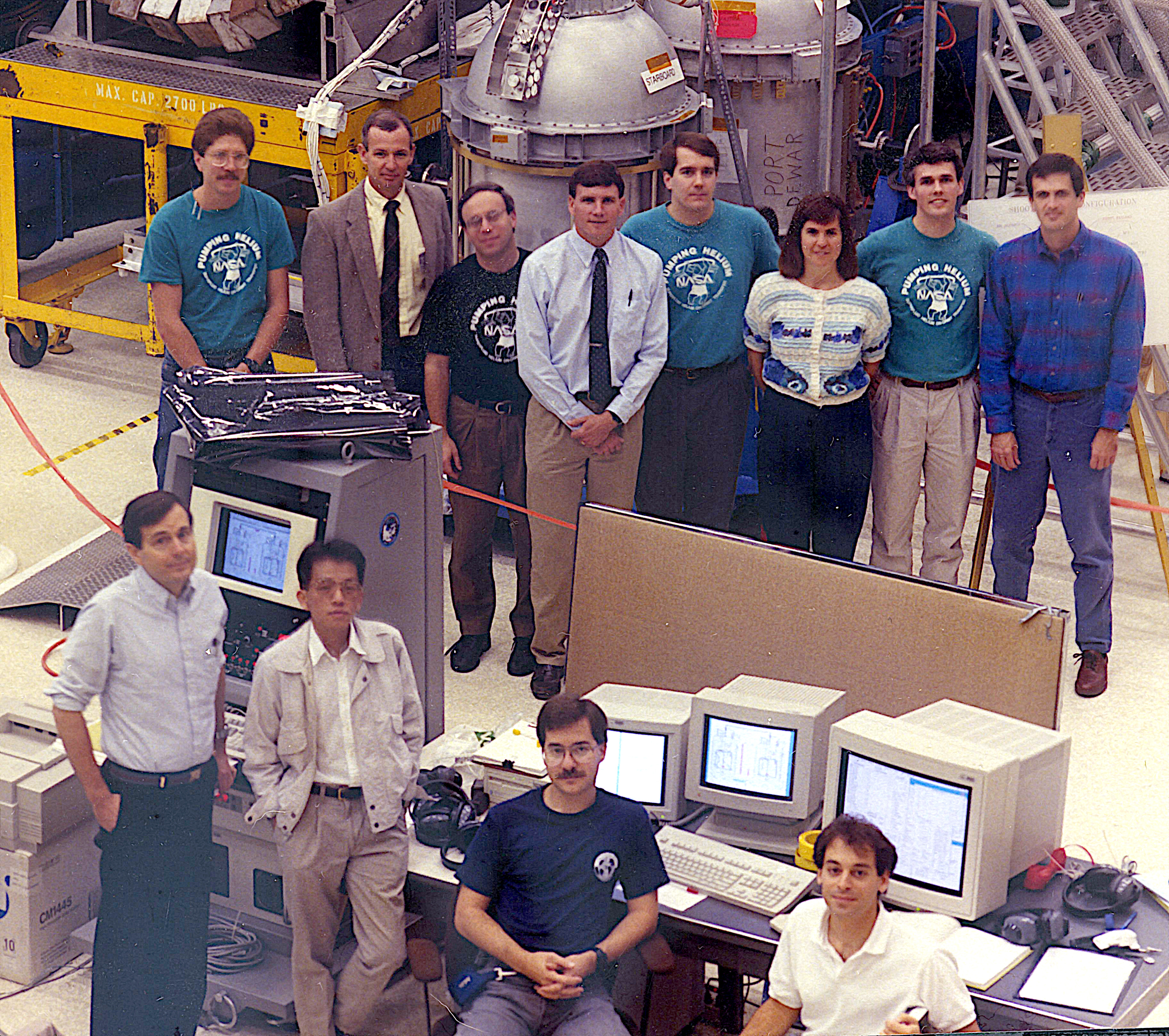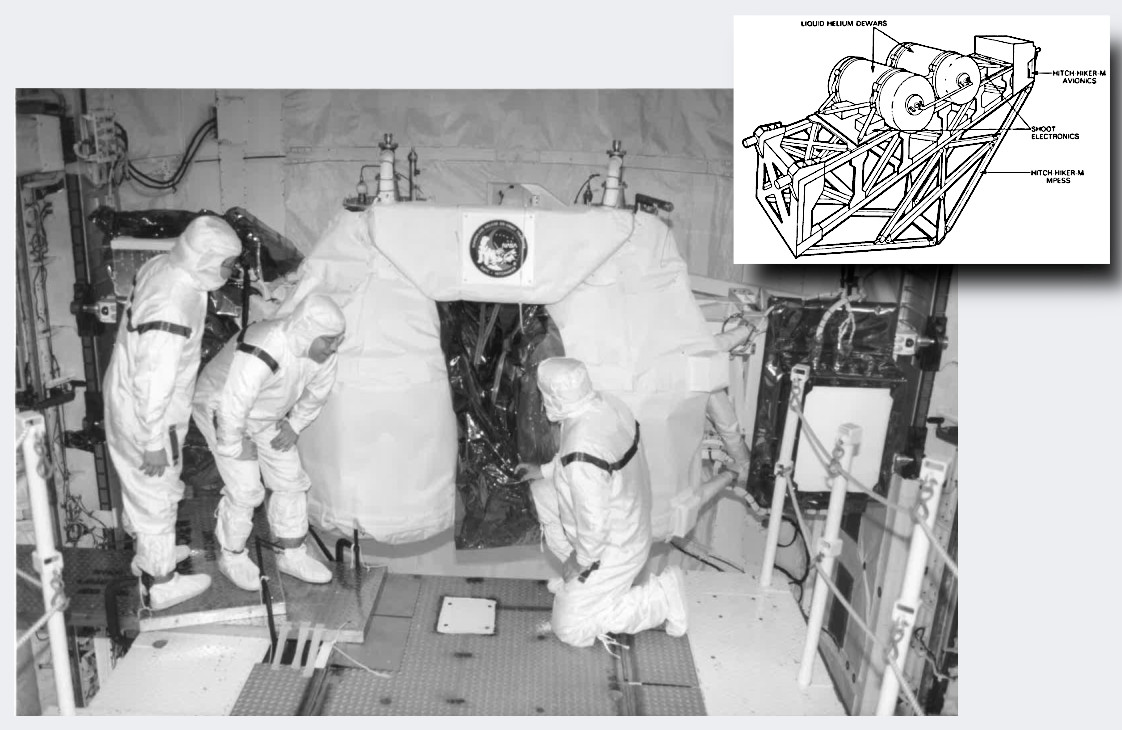 The '80s have been thrust back into our collective conscious! Hits such as Tracy Chapman's "Fast Car" and "Running up that Hill" by Kate Bush have been introduced to a new generation by an incredibly popular cover of the first song and the repetitious use of the second in a recent hit TV series. So, I thought it was appropriate to bring back something spaceflight-related from that decade. The Superfluid Helium on Orbit Transfer flight demonstration, SHOOT, was conceived in 1982 and executed by NASA Goddard Space Flight Center over the remainder of the 1980s.
The '80s have been thrust back into our collective conscious! Hits such as Tracy Chapman's "Fast Car" and "Running up that Hill" by Kate Bush have been introduced to a new generation by an incredibly popular cover of the first song and the repetitious use of the second in a recent hit TV series. So, I thought it was appropriate to bring back something spaceflight-related from that decade. The Superfluid Helium on Orbit Transfer flight demonstration, SHOOT, was conceived in 1982 and executed by NASA Goddard Space Flight Center over the remainder of the 1980s.
This was the era of the Great Observatories program at NASA. Of the four telescopes that defined the program: the Hubble Space Telescope, the Compton Gamma Ray Observatory, the Advanced X-ray Astrophysics Facility (AXAF, renamed to Chandra shortly before launch), and the Space Infrared Telescope Facility (SIRTF, renamed to Spitzer post-launch); two of them, AXAF and SIRTF, were anticipated to require superfluid liquid helium to operate their detector technology. As you likely know, informed reader, liquid helium enters a quantum-mechanical state at temperatures below 2.17 K. In this state, helium is called a superfluid due to some amazing properties. Well, a few clever low temperature physicists who wear engineering hats at Goddard asked the following question: “Can we extend these missions if a technology is developed to resupply liquid helium to observatories while on orbit?ˮ Then they asked, “Why stop there? Could a technology be developed to supply liquid helium in its superfluid state directly to these observatories?” This eliminates the loss of liquid since there is no need to first transfer 4.2 K helium and then reduce the temperature by pumping away vapor. Hence, SHOOT was born.
Both a demonstration and experiment, SHOOT was a pair of 210-liter liquid helium dewars with cryostat inserts. These two dewars were linked via a vacuum-insulated helium transfer line and could pump helium in either direction using the thermomechanical effect (aka the fountain effect) in superfluid helium. Since the transfer was designed to happen in a low-G environment, other issues needed to be solved—the lack of a well-defined fluid location on orbit being one of them. So, each cryostat contained a liquid acquisition device (LAD) that collects the liquid helium and directs it toward the thermomechanical pumps. (Actually, there was a different LAD in each dewar to experimentally verify which version was more effective.) Of course, there was the typical assortment of valves, pressure gauges and relief devices typically found in helium cryostats. Also, each dewar had a special device known as a porous plug phase separator. Its job was to prevent liquid in the superfluid state from rapidly creeping along the vent line and draining helium from a dewar quickly. This rascal plays a major role later in this column.
 The dewars and cryostats were designed, built and tested on the ground. This work was performed at Goddard in the same building that houses the cryogenics and fluids branch. (The first image shows the SHOOT team during a test campaign with the two dewars seen in the background.) Ground testing went well, so the focus shifted to the ultimate goal of demonstrating this in low Earth orbit. The International Space Station was not developed yet, so the bay of the space shuttle was the target. The inset in the image above shows the initial concept of how the demonstration would be mounted in the Shuttle bay, and the larger image is SHOOT in the bay of Shuttle Endeavor. This photo was taken in May 1993. On June 21 at 09:07:22, STS-57 left the ground with SHOOT along for the ride.
The dewars and cryostats were designed, built and tested on the ground. This work was performed at Goddard in the same building that houses the cryogenics and fluids branch. (The first image shows the SHOOT team during a test campaign with the two dewars seen in the background.) Ground testing went well, so the focus shifted to the ultimate goal of demonstrating this in low Earth orbit. The International Space Station was not developed yet, so the bay of the space shuttle was the target. The inset in the image above shows the initial concept of how the demonstration would be mounted in the Shuttle bay, and the larger image is SHOOT in the bay of Shuttle Endeavor. This photo was taken in May 1993. On June 21 at 09:07:22, STS-57 left the ground with SHOOT along for the ride.
On orbit, SHOOT successfully completed eight transfers of superfluid helium from one dewar to the other, meeting all objectives and delivering a considerable amount of useful data. Some of the larger accomplishments include the demonstration that one can transfer helium between dewars on orbit without disrupting the superfluid state; the testing of not one, but two different types of cryogenic liquid acquisition devices in a low-G environment; and the precise mass gauging of liquid helium in low-G. All this may be found in the literature. However, there were a few things that you won't get from anything published. I'll let Jim Tuttle, now retired from NASA, explain one of them:
“As part of the final launch preparations, we needed to lock-wire several bolt heads. When cutting off the excess wires, one piece unfortunately flew away and landed on top of our hardware. For a long time, nobody found it, but the Kennedy Space Center (KSC) people insisted that we keep looking. They claimed that even the smallest bit of FOD could cause damage during the launch. They never allowed any known debris to remain. Finally, Tom Hait's sharp eyes spied the wire, and he carefully removed it with tweezers. (Tom was an uber technician within the cryo branch for decades.) During all of this ‘overtime’ period, we feared that angry KSC facility folks would come in and ‘help’ us with our problems. Instead, I looked around and saw the pad technicians discreetly and quietly enter the facility and begin their preparations as far from us as possible. Nobody interacted with us at all; they left us undisturbed to work through our difficulties! It was impressive, and undoubtedly resulted from many previous experiences like ours.”
It's my understanding that the SHOOT team was watching a replay of the astronauts entering the shuttle bay after the bay doors had opened. What was captured on that video was a storm of debris exiting the bay when the hatch opened. The SHOOT team gave each other sideways glances since they were told that no debris can remain in the bay. The mission control personnel caught onto this and laughed out loud proclaiming something like, “Oh that? Well, it happens every time!” SHOOT initiated a more serious on-orbit event, where the porous plug mentioned earlier takes center stage. I'll let Mike DiPirro, the principal investigator of SHOOT, tell the story:
“In the first 24 hours of the mission, with the astronauts sleeping, the final part of the pump-down of the SHOOT dewars was occurring. The dewars had pumped from about 3.7 K down to about 2.2 K. It was time to open the high-flow separator valves and provide more direct pumping to space. Unfortunately, shortly after opening the valves, we received an alert that the shuttle was swinging more than six degrees off vertical, and the astronauts were awakened. The shuttle is placed in the gravity gradient attitude with the nose pointed toward Earth to minimize the disturbing noises caused by attitude control thrusters. It turns out that unexpectedly high vent rates of helium caused the shuttle's attitude to be perturbed, even though we had diffusers at the helium vents to minimize this effect. The onboard thruster easily overcame this extra venting momentum. At the time, we thought that our high-flow phase separators had failed mechanically.
We later discovered that late changes in the wall thickness of the phase separator inlet had increased the thermal impedance, which limited the effectiveness of the fountain effect. In turn, this allowed liquid helium to escape the helium tanks and flow into space. We lost 100 to 150 liters of helium over 10 to 30 minutes due to this. As this helium escaped the diffusers, some portion struck the inside of the shuttle bay (with no large heat capacity, so no effect on the shuttle equipment) and reflected off the concave shape, imparting momentum to the spacecraft. SHOOT was able to continue with its demonstrations with a reduced complement of about 150 liters of superfluid.”
I don’t think many people can say they jolted astronauts awake by swinging the entire shuttle! However, as I’ve heard said, “The worse the time, the better the story!” I think this qualifies as one of those examples. Anyhow, the data from SHOOT was analyzed, presentations created and papers written. The earliest results were presented at both the Cryogenic Engineering Conference and the Space Cryogenics Workshop in 1993. It’s possible you were in the audience for one of those presentations. It’s also possible you’ve never heard of SHOOT before this. In either case, I hope you enjoyed this brief insight into the NASA flight demonstration known as SHOOT.
Cheers, Mark
Image: In this image are people well-known to the cryogenics community: Mike DiPirro, Peter Shirron, and Jim Tuttle. If you know them, you should be able to pick them out. (Hint: look at the second row.) Also included are the astronaut mission specialists Janice E. Voss and Peter J. Wisoff, who were tasked with taking care of SHOOT while on orbit. They are third and first from the right in the second row. The two dewars are seen in the background.


